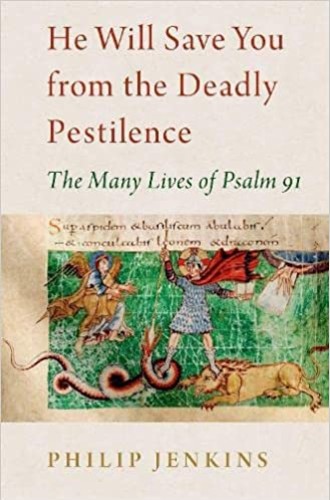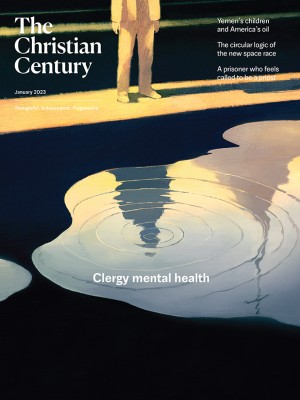A biography of Psalm 91
The deeper Philip Jenkins takes us, the more layered and fascinating the story becomes.
In generous and flowing prose, Philip Jenkins of Baylor University offers an inviting, nontechnical reading of Psalm 91 that is best described as a biography of the psalm. Focused on its reception over the centuries, through translation, interpretation, liturgy, and more, Jenkins’s study is refreshingly readable and engaging. One might think that a whole volume devoted to a single psalm would wear thin, but the opposite is true. The deeper the author takes us, the more layered and fascinating the journey becomes. Arguing that the psalm found its origins in the midst of an epidemic in Israel’s ancient past whets the appetite for application to the present day of global pandemic. While Jenkins touches on this, however, he doesn’t let it control the narrative he wants to present.
The book launches directly into “one of the most commonly cited writings from the Hebrew Bible.” Over the ages, Psalm 91 has proven to be impressively malleable, serving more Jewish and Christian communities than one can count (see “The travels of Psalm 91,” Jan. 17, 2018). In each, it has addressed people’s longing for hope within troubled times. For those varied circumstances, “the psalm is lavish in offering images of protection.” Demons, plagues, violence, and spiritual distress have all found remedies in Psalm 91. It has provided reassurance at deathbeds and shaped christological understandings. The motif provided by the psalm of trampling over enemies “has been extremely common in Christian art through the centuries” and was a fixture for hundreds of years in monastic compline services.
Read our latest issue or browse back issues.
Dating Psalm 91 to the fourth century BCE, Jenkins suggests that it might have been freestanding at one point rather than located within a broader collection of psalms. He reasserts the significance of plague as the occasion for the psalm: “It reads like a liturgy inspired by a severe biological onslaught.” Yet over the centuries its use turned toward prayer against evil spirits. The Qumran community, for example, ca. 60 CE, reinforced the use of the psalm as a weapon against demonic powers. This persisted through the Middle Ages.
Jenkins demonstrates both Psalm 91’s influence on the Gospels and its history of being read through christological lenses. The “serpent” and other beasts trodden underfoot are interpreted as ciphers of Satan, whom Jesus overcomes in Luke 4. Luke and Matthew ironically place the words of Psalm 91 in the mouth of Jesus’ tempter in the desert. Jenkins argues that this psalm “must be recognized as a key text for early believers as they tried to understand Jesus of Nazareth and to comprehend his life and death.” Irenaeus, among other patristic writers, deployed the psalm’s motif in soteriological accounts.
Jenkins perhaps makes too much of the intertextuality associated with Psalm 91. Although it is, as he claims, a source for certain phrases echoed elsewhere in scripture, it is not the only support structure for such cross-textual interaction, nor for the theological themes that emerge in later Christian writing.
From the fifth century onward, the first few words of Psalm 91 were treated as a charm against evil spirits, for “demons were ubiquitous and threatening.” In time, the psalm’s words migrated into mysticism and magical incantations and even inspired demonologies and angelologies. Still, there was resistance to the notion that words themselves could have healing or magical effects. The synod at Laodicea condemned the clerical use of amulets featuring Psalm 91. Even without the aura of incantation, Psalm 91 remained popular among monks struggling to maintain an ascetic life and to fend off “the perils of the darkness and sleep” as well as the “noonday demon” of acedia.
The motif of trampling enemies underfoot fit neatly into the triumphalism of Christendom in the medieval and early modern eras. Heretics were of special interest as candidates for trampling (Ps. 91:13), as were military opponents who could also be overcome by the trampling Christ and his trampling followers. Those who enjoyed the marriage of political and ecclesial power found in Psalm 91 a convenient description of their self-designated power and authority to subjugate their foes. The image of Christ the warrior was readily employed in art and architecture and was transferred, unironically, to those who claimed to follow in the way of Christ.
For Luther, the trampling of God’s enemies became the cause of every believer: “such triumphing over evil was a central part of Christian spiritual life.” To Luther, the lion, dragon, and other fearsome creatures of the psalm were Rome and her minions, as well as Jews and other heretics; to Rome, these despicable creatures were Luther and his coconspirators. Calvin, in contrast, “offered readings that were psychological rather than supernatural,” says Jenkins. Psalm 91 remained popular in the subsequent era of religious wars in Europe, and in Europe’s colonized territories it was a symbol of the supposedly rightful suppression of the “pagans” discovered abroad.
Charles Spurgeon is an example of a modern interpreter whose surrounding scientific culture attributed disease (such as cholera) to germs rather than demons. Even so, many in his time contended that illness was the will of God. All this follows centuries of evoking the psalm in times of pestilence: “Whenever plague struck Protestant societies from the 1520s onward, we can dependably rely on an outpouring of sermons and tracts on 91,” writes Jenkins. The emergent and unresolved issue was whether to become ill and perhaps die or to flee from the disease and take steps to avoid contact with it. (Here we may hear echoes of our own historical moment, in which believers dispute not only how to respond to COVID-19 but even if it exists. Jenkins does not draw attention to this.)
The high modern period sniffed at the notion that supernatural forces could protect anyone: “Educated people interpreted the psalm in ways that scorned or rejected what had long been the popular approach to its meaning and uses.” While the active entanglement of angels and demons in the mundane world was scarcely expected any longer, it was not uncommon to call upon divine protection such as that promised in the psalm. Still, most moderns (despite the counterexample of occultists and esotericists) were content with largely materialistic readings of Psalm 91.
Yet, Jenkins writes, “even in the post-Christendom West, the scripture still exercises much the same [supernatural] appeal that it did centuries ago.” The psalm evokes God’s protection and care, whether that is conceived as supernatural invention or as general beneficence of the Divine. Evangelical figures Billy Graham and John Piper have used Psalm 91 to exhort trust in God’s overall plan even when untimely death, illness, or disaster occurs. Michael Joncas’s popular liturgical song “On Eagle’s Wings” remains resiliently attractive after more than four decades. Soldiers have drawn on the lore and appeal of the psalm in recent wars. It has “been a mainstay of evangelical movements to promote Christian manhood, and of ‘prayer warrior’ groups,” says Jenkins. Most recently, advocates of the prosperity gospel have latched on to it.
The advent of the COVID-19 pandemic brought a resurgence of interest in Psalm 91. The apparent symbolism of “19” reversed as “91” has suggested to some that the psalm can function as a kind of totemic antidote (or supernatural preventative) to the coronavirus. In the Global South, Psalm 91 is evoked as a mode of combating demonic forces and diseases. It is especially embraced in Nigeria, writes Jenkins, where “ordinary Christians find the evils described in 91 represent a near-documentary catalog of the ills facing Nigerians in an age of disease [and] violent crime.” In Uganda, the title “Psalm 91” is “applied to fisheries and fish stores, to car rental firms and apartment blocks.” Many South Asian and Latin American Christians similarly embrace the psalm and its promises.
Jenkins concludes the book by asking if it is “still possible to use 91 . . . if we reject many of the key beliefs that have become so closely associated with it?” Although scientific materialism is the norm in our culture, many still pray earnestly for God’s supernatural participation in the world. Psalm 91 continues to be appealing, not least “in settings where other forms of worldly hope have been in short supply.” The constant need for hope among human beings means, says Jenkins, that Psalm 91 will be evergreen in its appeal.
With a gentle and lucid style, offering just enough data to demonstrate the substantial scholarship that underlies this study, Jenkins succeeds in reintroducing Psalm 91 to readers through many fresh lenses. This is historical interpretation at its best: erudite without being overbearing. I would have liked to see more reflection from the author on the significance of Psalm 91 for the COVID age, but he might share the tentativeness of many historians about offering judgment while a phenomenon is still unfolding. Overall, this is a delightful read that will appeal to both the historically minded and the biblically curious.






